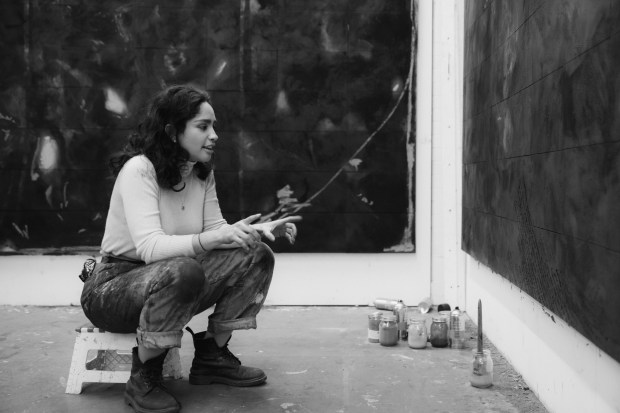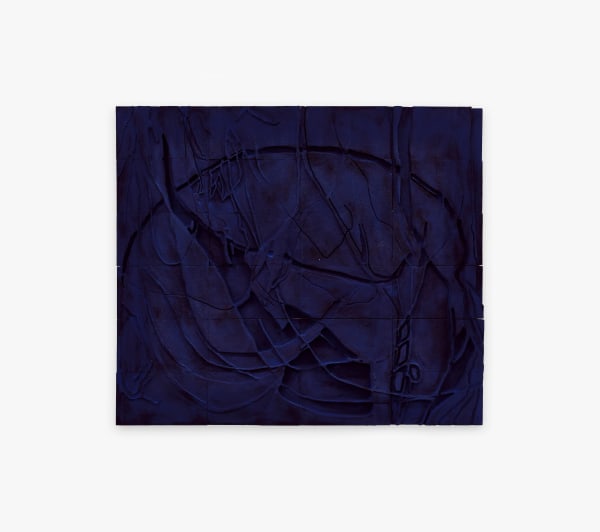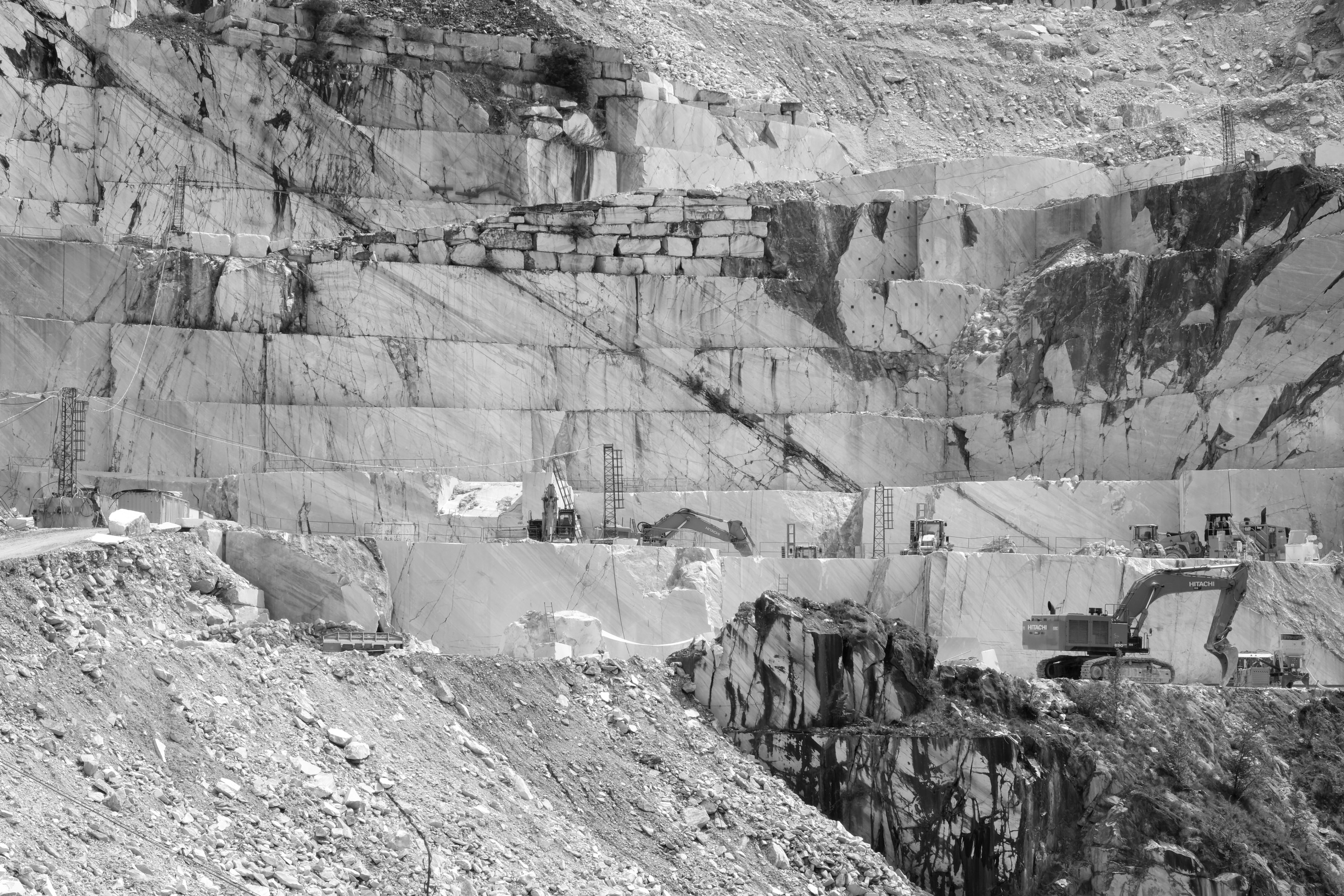Pia Ortuño: Down to the Roots
-

-
Beyond the Sea
By Matthew Holman
On the wall of her east London studio, Pía Ortuño has a scrap of
crumpled white paper with a handwritten note in bloodied red pen
which reads: ‘A myth is not something that never happened, but
something that repeats over and over again.’ In these lines, often
accredited to the Athenian statesman and poet Solon, Ortuño
recognises that myths are not deceptive stories which are widely
held to be true and ultimately false but rather one of our best ways
of understanding how the world moves in cycles, perpetually
repeating while never remaining wholly the same. Colour is a little
like this–and in the case of Ortuño’s painted sculptures, the richest
of marine blues–as colour repeats and repeats, albeit in subtle
changes of hue and gradient, but is often seen as impossibly itself
and irreducible to comparison. We seldom see the same blue twice.
Solon’s aphorism has high regard for our ability to imagine and
reimagine the world, and it is the creative imagination, he reminds
us, which exists with such as much life as any object we can touch
with our hands. Ortuño’s most recent body of work is in
conversation with these ideas of myth, memory, and the recurrence
of the creative imagination. In both halves of her sculptural practice,
in wood and in marble, she reveals objects which are at once
profoundly real, tactile, and material, and yet remain elusive.The title of Ortuño’s present exhibition, Down to the Roots, recalls ideas of returning to a place of origin, the elemental forces of
nature’s growth and decay, as well as the etymological root of words. To go back to the source. To start again. Ortuño, who was born in San José, the capital of Costa Rica, is constantly negotiating between her roots on the Caribbean Sea and the ever-
expanding branches of decisions taken in her adulthood. These have seen her establish a new life in London as she splits her time
between the capital and for long periods of time each year in Pietrasanta, a small Tuscan artisan town in the foothills of theCarrara marble mountains. While Ortuño’s works may seem to embody the ambiguous formal properties of pure abstraction they
never lose their profound sense of communion with the underlying codes and patterns of nature, whether that be the imperfect
curvatures of nests and seeds in her works in marble or the distinctly arboreal quality of the surface of her painted sculptures. In turn, both categories of works in this exhibition resemble the roots, dirt, soil, and perpetual renewal of trees, finding analogies in the timeless song of the oropendola bird and the way that the black lines or zone lines of frost rings collate information and stretch out
in time.
As her works evoke feelings of arching back across time (geological time as well as the time of memory, and so between her childhood and her present moment), Ortuño’s multidisciplinary practice speaks to the root of the word ‘nostalgia’, which is formed by the conjoining of nostos (to return home by sea) and algia (pain, or anguish). In these works, Ortuño yearns for the birds, vegetation, and impossible blues of Costa Rica in the same way that Renaissance painters craved for their Marian robes the deep blue pigments of ultramarine (literally meaning ‘beyond the sea’), which were originally imported from a single Afghan mine, Sar-e-Sang (the Place of the Stone). I am reminded of these stories on the history of colour partly because Ortuño’s work resembles the deep and unfathomable places of quarries and caves, the deepest places of the earth and the site of so much of her creative experiments in Carrara. Ortuño’s profound practice is to follow nature all the way through exquisite ruptures in the environment and down to the very beginning of things.
‘We love to contemplate blue’, wrote the poet Johann Wolfgang von Goethe, ‘not because it advances to us, but because it draws us after it’. Ortuño’s works operate on us in the same way. We are invited into the fractures and crevices of the surfaces, and as we get closer to them and begin to break apart the gridded logic of the modular structure in our mind, we get lost in our own imagined combinations. We realise that there is an underlying system here which we will never understand; we wait at the gate but cannot cross the threshold. Ortuño returned to painting in rich blues in 2022 and is now as committed to the colour as Yves Klein or Derek Jarman before her. It is the very blueness of Ortuño’s painted sculptures that places them in conversation with historical works which have also meditated on this colour as a pile of pigment, as something to dilute and swim in, as mystery and myth. With their blue modular cuboids which have been carved and transformed beyond likeness, there is an obstinate consistency of format and yet they revel not in their collective uniformity but in their individual singularity.
Ortuño describes herself as ‘a frustrated painter who sculpts.’ After she has completed the carving by attacking the surface of the smooth wood with a chisel, Ortuño takes the bruised and battered body from the wall and lays it down on the floor to receive preparatory layers. Ortuño seems to work on protecting her sculptures like a well-mannered fencer might ensure her rival’s lamé and plastron is all in place before and after going for the jugular. ‘My objects are always fighting back’, the artist reflects, with a smile that flashes across her face, as though recalling hard-won duels of old: ‘and the dust which is exhumed from the carving can be dangerous, so I must wear my own armour.’ With the surface still wet, Ortuño sprinkles layers of marble dust so that the surface is evenly coated. Working in this way, she is an artist who knows that the world returns to the world in paint insofar as every substance is a pigment if you grind it down to dust. Using her own pigments, Ortuño then rubs colour into every part of the surface as evenly as she can, using at least five or six layers of accumulative pigment to make the surface reach saturation and, in her words, ‘the final resting stage.’ Her battle has been won.
In a reworking of her own self-definition, it might also be true to say that Ortuño is a committed sculptor who paints. Everything that she knows about sculpture she has translated into painting. In the second sequence of works in this series, Ortuño has created elusive forms inspired by the transmigrations of nature in marble, having worked with master marbler Jorge Jimenez Deredia in his studio in Pietrasanta. This pocket of Tuscany has been an important centre for marbling since the Renaissance; today, the work is predominantly carried out by robots and processes of automation which forecloses the human element, and so the generational knowledge of the region hangs by a precarious thread. It was here that Ortuño learnt from Jimenez Deredia to make her own sculptures for the first time, working with hammer and chisel in the same fashion as the artisans. As in her painted sculptures in blue, Ortuño responds to the malleability of her subject with the devotion and the attention that attends extraordinary physical exertion. She attacks her subject in one moment, caresses its perforations the next. Sometimes the marble shatters into fragments and is then shaped almost entirely by its own volition, taking its own course; sometimes Ortuño works along an edge and then, as suddenly as lightning in a clear sky, the edge cracks and the entire strip is forever transformed. Space, then, becomes material. On Ortuño’s means of working, I am reminded of the Basque artist Eduardo Chillida and the ways in which, on his nature-inspiredsculptures, he navigated existential questions of what fate awaits the emptiness of space. In the work of both sculptors, space feels fuller when holes are excavated within them, and more present when areas of the surface are taken away. ‘Form springs spontaneously from the needs of the space that builds its dwelling like an animal in its shell’, Chillida said, ‘and just like this animal, I am also an architect of the void.’ Ortuño is also an architect of the void. Many of Ortuño’s marbles are inspired by nests, where occupiers change like the seasons, and seeds, especially those that travel by water and relocate across the sea – like nostalgia, like myth. Oropendola (2025), a vertical form with oval apertures, titularly responds to a Costa Rican bird who creates the most perilous dwelling places with their own entrances and exits and made form intertwined twigs. These are transient architectures which speak to the movement of life, like the sculpture springing spontaneously from the needs of the space. Elsewhere, Nido (2025), literally ‘nest’ in Spanish, resembles a giant seed or a cardinal’s hat, and responds, in the artist’s own words, ‘how in life everything is changing; life is most interesting when you’re thrown off balance.’
The surfaces of both iterations of Ortuño’s practice recall sacred and sacramental spaces: the stained glass of Chartres Cathedral, the ceiling of the Scrovegni Chapel in Padua, the midnight blues dancing on the lapping waters on the Isle of Skye. It is fitting, then, that Ortuño was reading Auguste Rodin’s essays on cathedrals while making this body of work. ‘I approach my practice as Rodin approached a cathedral’, Ortuño reflects, ‘imploring myself to understand it as painting, made in light and shadow and as sculpture, balanced and proportioned like the human body… Like the cathedral, it encapsulates time, containing traces, memories and echoes.’ To encounter Ortuño’s work up close is to come face to face with an object which cannot be comprehensively located in time: the modular forms of the painted sculptures, so internally fractured and yet so cohesively whole, unfold like a ruin, like a cathedral, like Liesegang rings; the marbles curve heavenward like Constantin Brâncuși’s birds in flight. These are all environmental and elemental works in the sense that they seek to track the physical transformations of the natural world and the impact that human activity has upon it. In this way Ortuño’s works feel opposite to Solon’s idea of the myth: they exist only once, irredeemable in time. -
-
-
-











